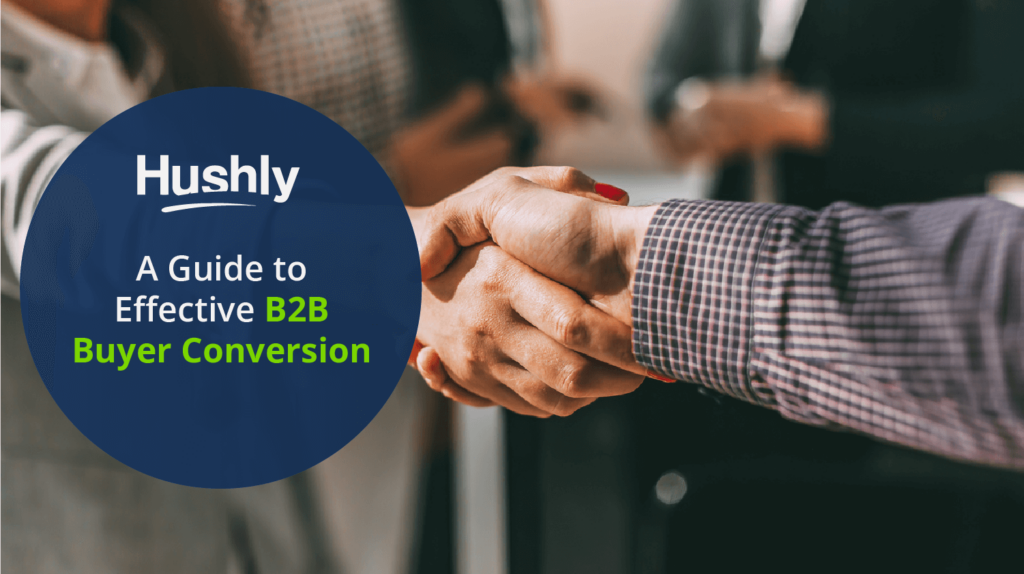Opportunities to optimize B2B buyer conversion happen at every step of the marketing process.
Whether you’re looking to generate more leads with fantastic video content, or ranking leads with automated data analysis, the forefront of technology and sales has never been more complex. This is confounded by the seemingly limitless ways you could approach the concept of optimizing your own buyer conversion strategies.
Marketing leaders looking for some clear road signs might end up with more questions than answers, which is why we’ve crafted today’s guide.

Where to Begin Optimizing B2B Buyer Conversion Rates
A simple change can make a world of difference. Whether the topic is marketing or something else, the concept of optimization is all about squeezing large amounts of gains out of small amounts of effort.
With this idea in mind, the first step to optimizing your B2B buyer conversion rates will be to identify your current strategy’s shortcomings. These will be your priorities.
Don’t ignore the data. It’s the most important tool for identifying your weaknesses and the path to optimization. The exploration phase should include a deep dive into sales, marketing, and lead reports and statistics to gather data that substantiates the changes you’ll need to make.
Once you’ve confidently found the phases of your buyer conversion which aren’t performing as well as you’d like, you’ve also identified the path forward.
4 Ways to Optimize Your B2B Buyer Conversion Rate
While your company will have specific B2B buyer conversion needs that demand tailored optimizations, there are universal steps that can have an impact on any marketing strategy.
We’ve compiled a list of four bedrock strategies that will immediately impact your B2B buyer conversion. These are straightforward avenues to improving your conversion rate at every step of your marketing process.
1. Informative and Frictionless Video Content
Video content is by far the most important to building trust and human interest in your brand. At every level of the chain of marketing, consumers prefer video content when learning about new products, education, leadership and direction, and explanations of complex topics.
Here are some impressive statistics from Wyzowl regarding video content:
- 96% of people have relied on video to learn about a new product or service.
- 88% say they’ve been convinced to buy a product or service by watching a video.
- 78% say a video has convinced them to buy a product or service before.
Videos are easier and more enjoyable for consumers, which is also why folks are twice as likely to share videos compared to other content.
A well-produced video tells a story that demands and holds the attention of an audience. This means video content is perfect for driving traffic to your website and keeping your brand’s name on people’s minds for longer.
So, what do we mean by frictionless?
Consumers come across your content with a certain intent, e.g., searching for a guide. If they confront a paywall that delays their access to the value they need, this is friction. This kind of roadblock to value is likely to drive away certain consumers who otherwise could have been converted to buyers.
By instead leading with value and putting video content alongside other relevant recommendations and offers, you will keep customer attention longer and drive-up conversion rates.
2. In-Depth Lead Scoring
Every member of the sales and marketing team knows that when it comes to lead generation, quality can often matter far more than quantity.
When leads are handed off to the sales department and not converted, the question of who is to blame will naturally arise. Sales will feel they converted all good-quality leads, while marketing will feel that some good leads were left unconverted or perhaps not even followed up on.
This type of friction can be detrimental to the entire buyer conversion process from marketing to sales, not to mention your company’s culture. The only way to ensure both sides feel fairly represented is to introduce an objective criterion they each have input on crafting.
This is called lead scoring, and it can directly lead to higher sales, more consistent conversions, and increased cooperation between your marketing and sales teams.
A great lead-scoring system should have the following traits:
- Simplicity: The fewer measurements needed to determine a good lead the better. An overcomplicated lead scoring system can take more time than it’s worth: too many criteria run the risk of getting bogged down in minutiae.
- Comprehensiveness: Define the steps for nurturing each lead and how the program will affect compensation. There should be no questions regarding the expectations of all involved.
- Modularity: You need to update the lead scoring system as your sales and marketing ebb and flow. Your lead scoring system might not be perfect immediately, and it should be subject to regular reviews and changes.
3. Situational Buyer Insights
The best buyer experience is simple: one where customers feel the seller understands and meets their needs.
A B2B buyer’s needs may be predictable in some respects, but their approach to business and the direction they plan to take their company won’t be. Buyers are human beings at the end of the day, and the insights, which help in making them feel unique, understood, and comfortable, are the key to successfully converting them.
The ability to make buyers feel relaxed and like the solutions your company offers rests on two important factors that you can optimize via training:
- Pattern recognition: Each sales situation is unique, but they are likely to include some fundamental premises you will encounter in every situation. These types of concerns are where your company’s bread and butter – the salespeople – should be well versed in the patterns that each buyer in your industry will demonstrate, so they can recognize and capitalize on them immediately.
- Empathy: This matters when your buyer feels overwhelmed by the amount of information and choices they face. Easy-to-digest content and a readily available support system are actionable items your sales team should have on hand to walk buyers through every step of the process.
4. Your Buyer Conversion Platform
From content and the generation of leads through the sales process, your conversion platform has a myriad of opportunities to convert sales and keep potential buyers’ attention for longer.
A good buyer conversion platform should be a resource that adds to and enriches your sales process rather than just facilitating it. A great B2B buyer conversion platform should also be a buyer experience platform, which means managing the buyer every step of the way and helping you maximize your B2B marketing strategy from content to account management.
The Hushly platform operates on four key principles: a great user experience, ease of deployability and use, flexibility with existing infrastructure, and consistent generation of verified, high-quality business leads.
At Hushly, we believe we can solve the B2B abandonment problem through constant innovation and a keen interest in the needs of our clients. We work with content marketers and lead generators in a variety of industries to optimize buyer conversion rates and maximize the buyer’s experience, so they keep coming back.
Convert More B2B Buyers Through Optimization
The path to optimizing your buyer conversion process can be clear with the right knowledge, processes, and partners.
By identifying and targeting your shortcomings, you can make easy strides with minimal effort. You can also focus on certain universal improvements which are sure to make a significant impact on your B2B sales conversions.
As your optimization journey continues, the opportunities will be fewer and require more effort. When that happens, Hushly is ready to learn your business’ unique needs so we can grow together.
Request a personalized demo showing what the Hushly platform could do for your B2B buyer experience needs.

